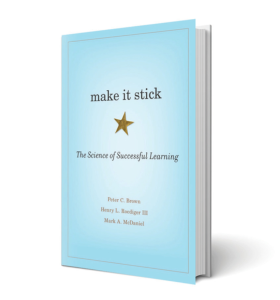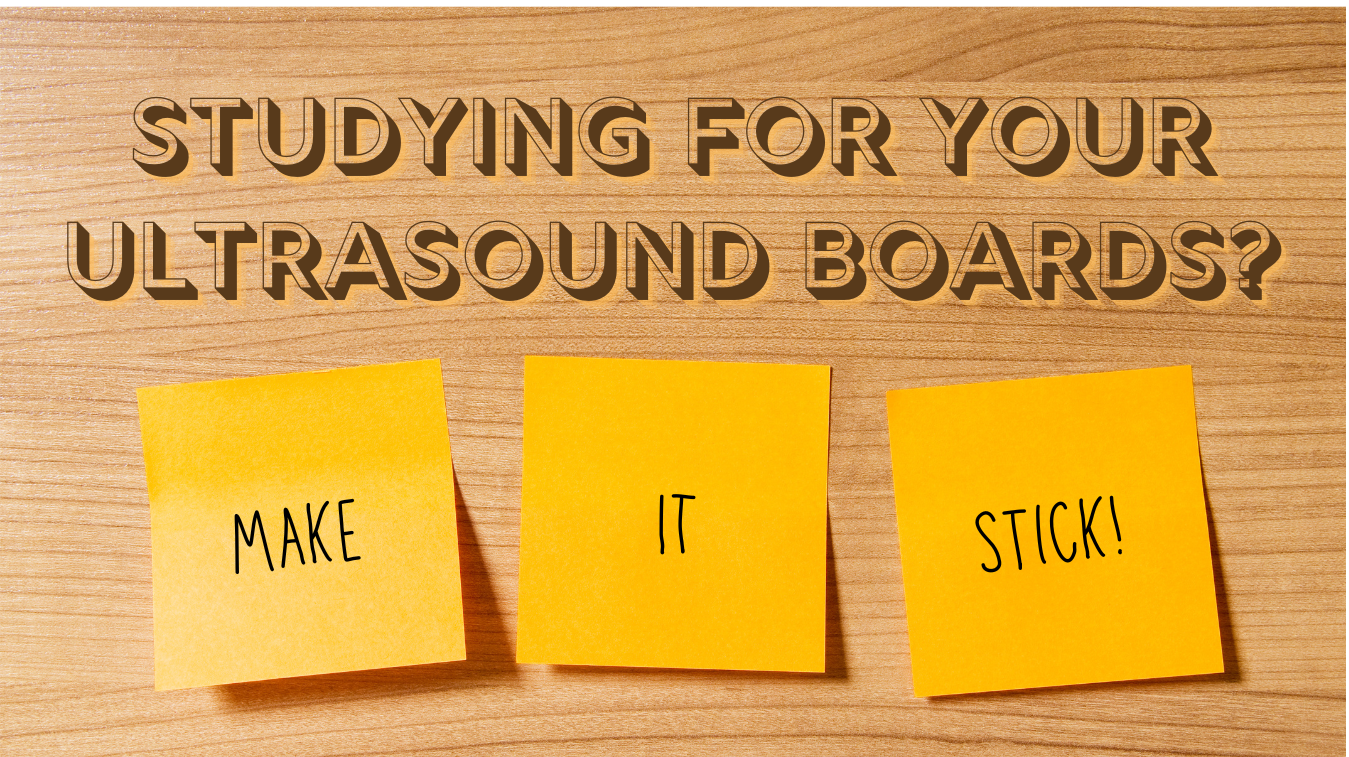There are many books out there on the science of learning, but if you’re studying for your boards, you probably don’t have enough time to read anything outside of your study materials.
So let me help you with a quick review of “Make It Stick: The Science of Successful Learning” by Peter C. Brown, Henry L. Roediger III, and Mark A. McDaniel.
 “Make It Stick” is an absolute game-changer for sonographers striving to pass their certification exams. This revolutionary book challenges traditional studying methods and provides evidence-based techniques that encourage effective learning, long-term memory retention, and practical application of knowledge. With its detailed insights and approachable tone, “Make It Stick” equips learners with the tools necessary to excel in their certification tests. Let’s check out the key learning strategies this book recommends for all learners.
“Make It Stick” is an absolute game-changer for sonographers striving to pass their certification exams. This revolutionary book challenges traditional studying methods and provides evidence-based techniques that encourage effective learning, long-term memory retention, and practical application of knowledge. With its detailed insights and approachable tone, “Make It Stick” equips learners with the tools necessary to excel in their certification tests. Let’s check out the key learning strategies this book recommends for all learners.
We’re going to explore 5 strategies from the book that sonographers can benefit from right now to enhance their learning and improve their performance:
- Embrace Active Learning
- Utilize Retrieval Practice & Spaced Repetition
- Include Interleaving and Variation
- Emphasize Metacognition & Reflection
- Incorporate Collaborative Learning and Teaching
1. Embrace Active Learning
“Make It Stick” advocates using active learning techniques rather than passive studying to truly absorb and retain knowledge. This means engaging in activities that require you to apply your knowledge actively, such as practicing with sample questions, like ESP’s X-zone, participating in case studies, and working through real-world scenarios. Doing so reinforces your understanding and improves your retention of the material.
So, don’t just read and highlight – figure out how to apply it at school or work.
Get it to gel:
Instead of passively reading textbooks, actively engage in practical activities. If you’re scanning for a specialty exam, use every patient’s medical history to build a mental list of differentials. Look at the labs and consider how that might affect what you’ll see on the ultrasound. Follow up on what you can to reinforce your learning. Were any of your differentials right? Was there something that sticks out about that case?
Or, if you’re getting ready for physics, try out concepts on a machine. After you study attenuation, try scanning with different frequencies and see what happens. Practice scanning techniques on models, participate in mock examinations, and attend hands-on workshops to reinforce your understanding and improve your skills.
2. Utilize Retrieval Practice & Spaced Repetition
Rather than going over material repeatedly without a plan, it is more effective to retrieve information from memory actively. The authors warn that by reading and re-reading, we trick ourselves into thinking we’re learning, but in actuality, we’re just recognizing the repeated content.
Active retrieval means pushing yourself to recall important details, diagnostic criteria, and essential concepts. Regularly practicing retrieval can strengthen your memory and boost long-term retention.
It’s also better to study a little bit at a time instead of cramming everything in one go. It’s called spaced repetition, and it really helps your brain remember things better.
Basically, you review the information, increasing the interval of time between each review. Things you know really well can have more space between reviews, whereas topics you don’t know as well should be reviewed every day (until it becomes something you feel confident in—then you don’t come back to it as often). This all helps your brain absorb the information, and the best part is that it makes recalling the information way easier!
Get it to gel:
Test your knowledge by creating flashcards or using online platforms to quiz yourself on anatomical structures, scanning protocols, and pathology recognition. Regularly challenge yourself to recall information and reinforce your memory.
Try hiding the multiple-choice answers and coming up with the correct response (this way, you know you’re recalling and not just recognizing).
ESP Ultrasound recently launched our Digital Quiz Cards on the Brainscape platform, which builds in spaced repetition for you, making this step a no-brainer!
3. Include Interleaving and Variation
Interleaving is a learning technique that involves mixing up topics or forms of practice. So, to improve learning, consider changing the topics you’re studying instead of just focusing on one thing. You can also change up the way you’re practicing. Don’t rely on just multiple choice mock exams. Try involving flashcards or mind mapping.
Get it to gel:
Rather than focusing solely on one type of organ, pathology, or physics concept, mix and alternate between different ultrasound applications. Try studying anatomy for a little bit, then jumping to bacterial infections and going back to patient care. This type of learning makes it feel more difficult, but ultimately, you’ll be more prepared.
4. Emphasize Metacognition & Reflection
To enhance your metacognitive abilities, it is essential to monitor your cognitive processes and comprehension actively.
If you’re not sure what metacognition even means, think about people who go on American Idol, a singing competition. Those with poor metacognition cannot recognize that they aren’t very good singers. Similarly, students might also have the wrong impression of their own learning. Metacognition in learning is thinking about your learning.
To improve your metacognition, carefully reflect on your learning experiences, pinpoint areas lacking knowledge, and modify your study methods accordingly. It is also beneficial to seek feedback from those around you, be it peers, mentors, or instructors, to gain valuable insights into your learning and continuously improve your cognitive skills.
Don’t be afraid of making mistakes – they’re actually great chances to improve and grow! Take a close look at your slip-ups, figure out why they happened, and adjust your approach. By reflecting on your mistakes, you can learn a lot and make sure you don’t make the same ones again later on.
Get it to gel:
Sit down with a peer, mentor, or tutor and just talk through a topic at your level of understanding. By doing so, you might be able to recognize deficiencies or get feedback on the accuracy (or inaccuracy) of what you know.
 5. Incorporate Collaborative Learning and Teaching
5. Incorporate Collaborative Learning and Teaching
There are a ton of ways to enhance your learning through collaboration. Sonographers can engage in study groups, share challenging cases, and teach their peers. Explaining concepts to others reinforces personal learning and helps identify areas that need further development (metacognition!).
Get it to gel:
Form a study group or find someone who can support you during your studies. Once in your study group, share resources, teach one another, and create study guides or quizzes. You’ll gain a lot of insight and mutual support for your learning. Maybe you’re a seasoned sonographer who has to take the SPI now. Consider taking a student and making a point to work on physics topics together.
There are many social media groups that might help you connect with other sonographers in a similar situation or consider hiring a tutor.
In your journey toward passing your certification exams, I urge you to apply these evidence-based techniques from “Make It Stick” and incorporate them into your study routine. By embracing active learning, utilizing retrieval practice and spaced repetition, including interleaving and variation, emphasizing metacognition and reflection, and incorporating collaborative learning and teaching, you can enhance your learning experience, improve your retention of knowledge, and increase your chances of success on the boards. Remember, the path to becoming a skilled and knowledgeable sonographer is paved with effective learning strategies and a commitment to continuous improvement. So, make it stick and achieve your goals!



